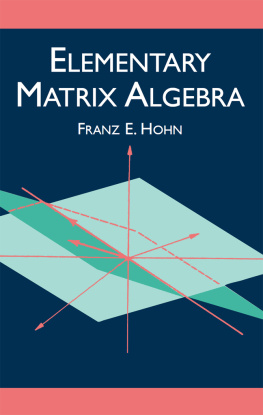Larissa Fradkin
Elementary Algebra and Calculus
The Whys and Hows
Elementary Algebra and Calculus: The Whys and Hows 2015 Larissa Fradkin & bookboon.com
ISBN 978-87-403-0151-9
Contents
Part I Introduction 7
Part II Concept Maps 8
Part III Lectures 10
Lecture 1 ALGEBRA: Addition, Subtraction, Multiplication and
Division of Rational Numbers 11
Lecture 2 Applications of Elementary ALGEBRA: Solving Simple Equations 30
Lecture 3 ALGEBRA: Exponentiation, Roots and Logarithms of Real Numbers 42
Lecture 4 FUNCTIONS 52
Lecture 5 Real FUNCTIONS of One Real Variable: Graphs, Polynomials 64
Lecture 6 Real FUNCTIONS of One Real Variable: Exponential Functions,
Logarithmic Functions, Inverse Functions 74
Lecture 7 Real FUNCTIONS of One Real Variable: Trigonometric Functions, e Graduate Programme I joined MITAS because Inverse Trigonometric Functions, Hyperbolic Functions

for Engineers and Geoscientists I wanted real responsibili I joined MITAS because www.discovermitas.com e Graduate Programme


for Engineers and Geoscientists

I wanted real responsibili Maersk.com/Mitas







Real work
InternationaalInternational opportunities
ree work placements
Month 16 I was aI was a construction Month 16
supervisor in I was a construction the North Sea advising and helping foremen
supervisor the North Sea advising
solve problems helping for
International opportunities
ree work placements solve problems
Lecture 8
Lecture 9
Lecture 10 ALGEBRA: Addition of Complex Numbers, the Argand Diagram,
Forms of Complex Numbers 106
Lecture 11
Lecture 12
Lecture 13
Lecture 14
Lecture 15

www.job.oticon.dk
Lecture 17 Application of DIFFERENTIAL CALCULUS to Approximation of Functions: the Taylor and Maclaurin Series 175
Lecture 18 INTEGRAL CALCULUS: Integration of Real Functions of
One Real Variable (Definite Integrals) 185
Lecture 19 INTEGRAL CALCULUS: Integration of Real Functions of
One Real Variable (Indefinite Integrals) 194
Lecture 20 INTEGRAL CALCULUS: Advanced Integration Methods 207
Lecture 21 INTEGRAL CALCULUS: Applications of Integration 217
Lecture 22 Ordinary Differential Equations 224
Part IV Summaries 232
Part V Glossary 249
Part VI Study Skills for Maths 255
Part VII Teaching Methodology (FAQs) 258
WHY WAIT
PROGRESS?
DARE TO DISCOVER
Discovery means many different things at
Schlumberger. But its the spirit that unites every
single one of us. It doesnt matter whether they
join our business, engineering or technology teams,
our trainees push boundaries, break new ground
and deliver the exceptional. If that excites you,
then we want to hear from you.
careers.slb.com/recentgraduates
FOR

Elementary Algebra and Calculus Introduction
Part I Introduction
These notes are based on the lectures delivered by the author to engineering freshers at London South Bank University over the period of 16 years. This is a University of widening participation, with students coming from all over the world, many with limited English. Most also have limited mathematical background and limited time both to revise the basics and to study new material. A system has been developed to assure efficient learning even under these challenging restrictions. The emphasis is on systematic presentation and explanation of basic abstract concepts. The technical jargon is reduced to the bare minimum.
Nothing gives a teacher a greater satisfaction than seeing a spark of understanding in the students eyes and genuine pride and pleasure that follows such understanding. The author believes that most people are capable of succeeding in and therefore enjoying college mathematics. This belief has been reinforced many times by these subjective signs of success as well as genuine improvement in students exam pass rates. Interestingly, no correlation had ever been found at the Department where the author worked between the students entry qualification on entry and the class of their degree.
The book owns a lot to authors students too numerous to be named here who talked to her at length about their difficulties and successes, see e.g. Appendix VII on Teaching Methodology. One former student has to be mentioned though Richard Lunt who put a lot of effort into making this book much more attractive than it would have been otherwise.
The author can be contacted through her website www.soundmathematics.com . All comments are welcome and teachers can obtain there a copy of notes with answers to questions suggested in the text as well as detailed Solutions to Home Exercises.
Good luck everyone! Elementary Algebra and Calculus Concept Maps
Part II Concept Maps
II.CONCEPT MAPS
Throughout when we first introduce a new concept (a technical term or phrase) or make a conceptual point we use the bold red font. We use the bold blue to verbalise or emphasise an important idea. Two
Throughout when we first introduce a new concept (a technical term or phrase) or make a
major topics are covered in this course, Elementary Algebra and Elementary Calculus.
conceptual point we use the bold red font. We use the bold blue to verbalise or emphasise an important idea. Two major topics are covered in this course, Elementary Algebra and Here is a












 for Engineers and Geoscientists I wanted real responsibili I joined MITAS because www.discovermitas.com e Graduate Programme
for Engineers and Geoscientists I wanted real responsibili I joined MITAS because www.discovermitas.com e Graduate Programme
 I wanted real responsibili Maersk.com/Mitas
I wanted real responsibili Maersk.com/Mitas










 www.job.oticon.dk
www.job.oticon.dk Elementary Algebra and Calculus Introduction
Elementary Algebra and Calculus Introduction